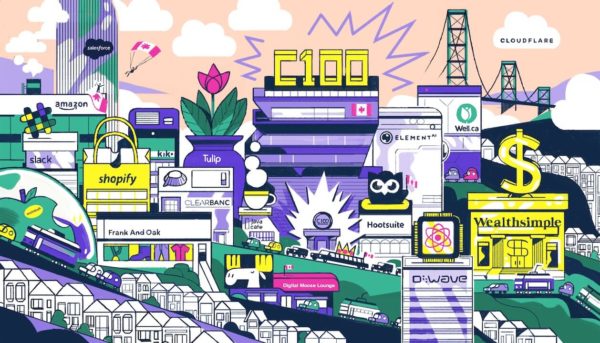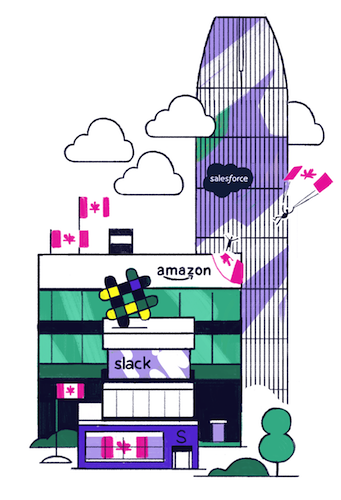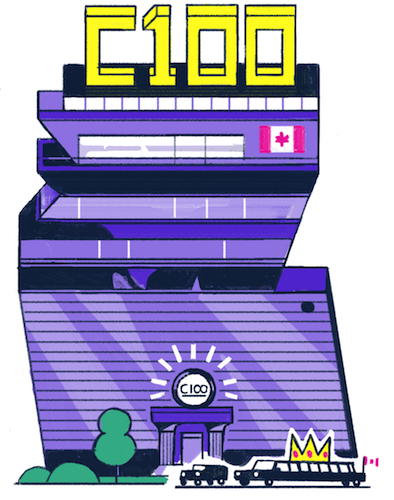
Posts Tagged ‘brain drain’
How Canadians Took Silicon Valley… And Never Owned the Win
Tuesday, June 12th, 2018
[Original story here: https://thelogic.co/news/the-big-read/origin-story-canadians-in-silicon-valley/]

Lars Leckie knew C100 had arrived when he was walking down the street in downtown Toronto a few years ago, crossing an intersection while wearing his C100 jacket. A young entrepreneur stopped him mid-stride, and introduced himself. ââItâs so great to meet someone from the C100!ââ Leckie recounts the man telling him. âAnd Iâm like, âIâm just in downtown Toronto, Iâm not at an office where you expect to see startups,ââ says Leckie. âIt was pretty cool.”
Bay Area venture capitalists like Leckie, managing director at Hummer Winblad Venture Partners, rarely get that kind of open-mouthed rock-star treatment in Silicon Valley, although they are a key part of its mystiqueâthe golden-robed men and women who, like ancient Roman emperors in the Colosseum, control pollice verso the fate of companies and the circulation of economy-altering sums of money.
But together, the charter members of C100 have inspired their own mystique, a coveted stamp of approval. C100 is a small, member-driven non-profit that connects Canadian tech entrepreneurs with the Valleyâs top Canadians in the industry. Hundreds of companies apply for 48 Hours in the Valley, its signature program, each year. Only 20 are selected. The pitch session trainings and mentorship that CEOs receiveânot to mention introductions to fundersâhave contributed to the growth of companies like Clearbanc, Frank And Oak, Kik, Wealthsimple, Tulip and Well.ca.
All told, more than $3 billion in venture capital was invested in Canada in 2017, and another $3.2 billion the year before that. C100 estimates that the funds companies with a C100 connection since 2010 easily stretches into the billions. Yet the story of Canadian excellence in the Valley is fraughtâand not just by conversations at home about âbrain drain,â even as Canadian entrepreneurs continue to derive a net benefit from the training they get from U.S. universities and tech jobs. The other issue is the hidden history of Canadian success itself.
In its reluctance to acknowledge the realities of the modern tech diaspora, Canadiansâor the Canadian press, at any rateâhave inadvertently overlooked the names and diminished the achievements of generations of Canadians who handed the baton to the tech workers transforming our digital economy.
The resulting lacuna may seem benign, but it has had real consequences for todayâs tech talent, according to Canadians I spoke to in the Valley. Itâs fostered a hesitation for Canada to celebrate its winsâand has affected Canadian entrepreneursâ tendencies to see themselves playing a bigger role on the world stage.
âAmericans are so good at telling the entrepreneurial story and Canadians need to improve. In the mythology of Silicon Valley, we are surrounded by the Elon Musks, the Steve Jobses. Who are those people in Canada? Most kids in high school donât even know who Tobi LĂźtke is,â says Anthony Lee, a managing director at Altos Ventures and co-founder of C100, referring to the founder of Canadian e-commerce behemoth, Shopify.
People here like to say that the longer you live outside Canada, the more fiercely Canadian you become. The charter members of C100âa Whoâs Who of Canadian technoratiâpay for the privilege of participating in events and volunteering their time, not the other way around. Leckie defines the job as âmaking sure that people know Canada is kicking ass.â
He meets me at his officeâa bright, wood-beamed space whose windows overlook San Franciscoâs Pier 33, where tourists queue up along the ferry dock to Alcatraz. In a previous life, before attending Stanford University, Leckie was a member of the Canadian Sailing Team, who represented his home country at the Pan American Games. But the plaque he keeps in his office has nothing to do with sailing competitions. He excuses himself and comes back a minute later to show it to me: a hockey puck mounted on a trophy base, presented to Leckie by C100 to thank him for his work as an inaugural co-chair of the organization.
Yet judging by how Canadians back home perceive the diaspora, people like Leckieânot to mention Lee and his C100 co-founder Chris Albinsonâcould represent the face of the âbrain drainâ as much as any of the young engineering grads migrating down from the University of Waterloo or the University of Toronto today. They had intended to come to the Bay Area for a year or two before returning home, but ended up staying. They are giving their time (and, sometimes, money) to help Canadian companies succeed. But they are agnostic on the question of where Canadians should locate their startups, at least in the beginning stages.
âWe think people ought to be in the ecosystem here, to be a part of it. If you want to be a giant in tech, you have to spend some time down here. But you donât have to stay here,â says Lee.
Albinson cringes at âbrain drain.â âItâs a term I find horrifically bad for the country,â he says. âNo, weâve always been about supporting Canadian entrepreneurs. But if youâre only doing Canadian entrepreneurship in Canada, that gets away from this idea of flow. There should be no barrier for capital, people or information.â
Some of the people I interviewed for this story live in the Bay Area, while some have returned home to Canada. But none of them say their career trajectories would have been possible had they stayed in Canada, rather than coming to the U.S. for work experience. Thatâs changing now, but there is too much precedent to think it will end any time soon.

The early 1990s saw a wave of Canadians pouring into the Valley on the crest of the telecom boom. Two cohorts preceded them, but their names and stories are not widely known. This is where the details get sketchy, owing to a lack of published materials. Itâs hard to piece together a narrative from the paucity of recorded histories: unlike the volumes of work on Americans (including American immigrants) and their successive technologies, the body of information on Canadian tech achievers is, for the most part, paper-thin.
Iâm not the only one whoâs noticed, either. âIâve not come across an historian of Canadian technology. If you find said person, please share their name with me,â John Stackhouse tells me. The former editor-in-chief of The Globe and Mail now works for RBC, and is writing a book on the Canadian diaspora. He helped a bit with the following history.
Canadians at U.S. engineering schools in the â40s and â50s undertook advanced studies and research as part of the Cold War nuclear academic arms race. Starting in the â60s, Canadians are thought to have worked at companies like Fairchild Semiconductor, one of the early chipmakers that helped Silicon Valley get its name.
In subsequent years, Canadians were among the engineers who developed software programs, modems and routers at companies on both sides of the border. The University of Waterlooâs computer science program was established in 1964, soon becoming one of the biggest of its kind in the world, catching the eye of companies like IBM. Around that time, U.S. companies started hiring Waterloo grads, a tradition that continues today.
Some important names come up in conversations that track the origin story of Canadians in the Valleyâpeople of Canadian descent whom some of todayâs tech cohort have claimed as their forebears. Cecil Green, co-founder of Texas Instruments, was born in England and raised in Vancouver, where he studied at the University of British Columbia in the â20s. His financial gift helped build the universityâs Green College and a visiting professorship program. Gururaj âDeshâ Deshpande is an Indian immigrant who studied at the University of New Brunswick (UNB) and Queenâs University in the late â70s. He worked at a Motorola subsidiary in Toronto and later co-founded Sycamore Networks, one of the biggest IPOs of the telecoms era, and endowed an innovation centre at UNB. And then thereâs James Gosling, the father of the Java computing language, who was born and raised in Calgary and worked at Sun Microsystems for nearly three decades before moving on to Oracle, Google and Amazon Web Services.

By the â90s, Canadians were thick on the ground in early computer software, graphic design, telecoms and mobile. And then they started climbing the masts of the Silicon Valley flagships: Shaan Pruden at Apple, Jeff Skoll at eBay, Don Listwin and Rob Lloyd at Cisco, Jeff Mallett at Yahoo, Doug Roseborough at Oracle and Rob Burgess at Macromedia (now Adobe). The list really does go onâand thatâs before you get to todayâs top Canadians who occupy the upper ranks at marquee companies like Facebook, Dropbox, Uber, Google, Salesforce, Zynga and Slack.
Silicon Valley Canadians of the late â90s and early aughts didnât have a lot of ways to find each other. There wasâand still isâthe delightfully-named Digital Moose Lounge, which hosts social gatherings like Canada Day events. Aside from that, people were mostly dispersed, ending up camouflaged among American colleagues at work. Later, when LinkedIn came along, Leckie created a âCanadians in the Bay Areaâ LinkedIn group, and Canadians started self-identifying. That helped form the basis for C100âs early outreach.
The Canadian ability to blend in has made it surprisingly difficult to pin a number on the population of expats in the Bay Area; various estimates peg it at somewhere between 250,000 and 350,000. Not even Rana Sarkar, consul general of Canada in San Francisco and Silicon Valley, knows for sure. He says, âA good chunk may have dual passports andâŚare inadvertent Canadians: either their parents are Canadian, or they moved down here at a young age or theyâre laying low and have married an American.â
But the central question of what constitutes a Canadian is an interesting one, he reckons. What about people like Deshpande and Musk, who passed through Canada and occasionally reference their maple-leaf roots? âIf someoneâs mom or dad is a Canadian and theyâve only visited the country a few times, does that mean theyâre a Canadian of interest?â Sarkar asks. If the answer is yes, the narrative of the Canadian diaspora will need to be expandedâand many in the Valley think Canada will the better for it.
â
Thereâs an expression Albinson, the C100 co-founder, uses often: âWhen the United States catches a cold, Canada catches the flu.â In 2008, Canadaâs tech sector had a bad flu in the midst of the financial crisis. âCanada, as an innovation economy, was on deathâs door,â he recalls. âThere was no venture capital. There was no angel money. And all over the country, entrepreneurs were losing their companies. Nortel was dead, Research in Motion [known as BlackBerry] was wobbly.â
It took a crisis for Canadians of the Valley to see themselves as a collective asset.
In addition to co-founding C100, Albinson is co-founder of Founders Circle and Panorama Capital. A Kingston boy, he was always intrigued by a painting of the Golden Gate Bridge that his grandmother brought home from a trip to San Francisco. He dislikes hierarchy and the East Coast. And he loves the weather and beauty of his adopted home of Larkspur, a little town in Marin County, Calif., where he meets me in the garden patio of a restaurant with fountains and birdsong.
Back in 2002, when he was a venture capitalist at JP Morgan Partners, Albinson was part of a trip to India designed to showcase the countryâs goal of becoming a technology leader by 2020. In Delhi, he witnessed the benefits of viewing Indian expatriates not as a lost liability but rather as an asset. The Indus Entrepreneurs (TiE) is a Silicon Valley-based non-profit that connects entrepreneurs with South Asian roots around the world with funding, networking, education and mentorship. Founded in 1992, TiE became a model for C100 to emulate in building its own support ecosystem for expats.
By contrast, in 2008, Canada had few startup incubators. And it had a tax law requirement that made foreign venture funding of Canadian startups so difficult that investors were skipping the country altogetherâCrunchbase called it âa leper colony for tech entrepreneurs.â Canada eliminated the tax section in 2010, after lobbying by stakeholders like C100, says Albinson.
âWe realized the Canadian environment was very fractured,â says Albinson. âOne of the reasons why Canada wasnât having that much success wasnât that the entrepreneurs werenât good, but because the ecosystem around them was a mess.â
Albinson and Lee hatched C100 together just minutes after first meeting at an event in Palo Alto sponsored by the Canadian government. The consul general wanted to recruit them to a business advisory board to stimulate industry connections, but they had a better idea.
In January 2009, Albinson stood in front of the 85 most successful Canadians in a conference room on Sand Hill Road, the so-called âWall Street of the Westâ in Menlo Park, Calif.. He cleared his throat and issued a call to action on behalf of their homeland. âI looked them in the eye and said, âYouâve had the privilege of a passport, youâve had an amazing education. Because youâre in this room, youâve had a lot of success down here. You have a responsibility. We want to start this. You owe it to these entrepreneurs to do this.ââ
Lee says they felt inspired by Own the Podium, the national campaign (now a non-profit) to invest in Canadian winter sports that helped make Canada the top gold-medal finisher at the 2010 Vancouver Olympics. âIt was very un-Canadian to say, âWeâre going to win,ââ says Lee, âand I think it was kind of a turning point for the Canadian psycheâ (Later, C100 created its own video homage to Own the Podium with a Silicon Valley twist: âItâs about claiming the podium as ours, painting it red and white, crushing it and sprinkling the dust into the eyes of our competitorsâ).
Albinson and Lee werenât sure if their pitch would work. It was a novel ask, and people inside the room had no reason to contribute, other than their patriotism. âWhat I didnât know was, did the thing that burns inside me about being Canadian, was that in everybody?â says Albinson.
Nearly everyone took out a pen and wrote a cheque for US$850.
â
What a difference a decade makes. As Canadaâs tech sector gains traction, government support and major venture capital from south of the border, the freshly-laid infrastructure convinces top Canadians in the Valley that the growth trend will accelerate. Itâs when someone like Montreal native Patrick Pichette moves on from his role as CFO at Google and turns venture capitalist, joining iNovia with the express purpose of elevating Canadaâs best startups. Or when homegrown Hootsuite hero Ryan Holmes uses his success to build a national entrepreneurship accelerator to help youth in Canada launch the next big thing.
In 2017, Canadian companies comprised 14 per cent of the Deloitte Technology Fast 500, which tracks the fastest-growing tech companies in North America, up roughly three per cent from the year before.
Today, itâs U.S. venture firms that are working to get in front of Canadian entrepreneurs. Andrew DâSouza, co-founder and CEO of fintech service company Clearbanc, says he personally hears from at least one U.S. venture capitalist a week, usually from San Francisco or New York, asking him for advice on whom they ought to be meeting with in Toronto. âPeople are starting to wake up and realize thereâs great talent and great companies built here,â he says.
Itâs no longer strictly a requirement for Canadian entrepreneurs to knock on Silicon Valley doors for Series A funding, or even to base their companies in the Bay Area, says DâSouza. But you do need a âgood connectionâ in the Valley, if only to level-set with the competition. âIn Canada itâs very easy to be a big deal before youâve accomplished very much. You can get in The Globe and Mail and you can get on TVâŚ. Itâs helpful to be able to look up and realize youâre actually competing on a global scale.â He co-founded Clearbanc in San Francisco in 2015, but a year later, it was clear the conditions were right for a move to Toronto. Now he recruits from both countries.
Albinson talks about being Canadian as though it were a superpower. âYou tell people, âIâm Canadian,â and suddenly youâre into three levels of trust. You need to be very, very careful with that. Thatâs one of the things I tell the C100 folks: we have this amplification that weâve been entrusted with, whether we know it or not.â

More than a decade after Canadaâs telecoms era sputtered, the countryâs tech economy has all the ingredients it needs to dominate. Whatâs missing right now may not be something C100 can provide.
âItâs almost just a matter of confidence,â says Lee. âOne thing Iâve noticed is that Canadians working in any industry will pay more attention to Canadians outside the country. Canadians have always needed outside validation. Itâs always been part of the culture.â
He pauses. âPart of what weâre trying to say is, âStop it, already.ââ
Americans donât need to name their success stories constantly because theyâre all sewn into the mythology. Theyâve managed to make all their disparate stories into American onesâto give them an inevitability. But in this case, history is being made in real time by Canadians at home and abroad in an industry that has little narrative of its own.
Canadians will recall getting intermittent history lessons on TV in the â90s by way of âHeritage Minutesââ those iconic national video clips depicting important Canadian moments. Theyâre how we learned about Canadaâs contributions to basketball, Superman and even the real-life bear that was said to have inspired Winnie the Pooh. But why not the father of Java?
âI grew up during the Canadian iconography era,â says Leckie, referring to those film clips. âItâs always been my goal that Canadian tech would have that moment in the sun.â
If that happens, it will need to include the Silicon Valley diaspora.
Tags: brain drain, C100, Canada, Julia Scott, Silicon Valley, The Logic
Posted in Feature | No Comments »
© 2025 Julia Scott.